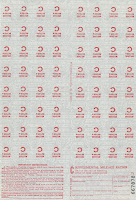 |
| Mileage stamps |
Today, these ration books are not only historically significant, but aesthetically appealing, as the government used patterns, watermarks, and color to deter counterfeiters. Most of the symbols were patriotic and bellicose, ranging from eagles and American flags to tanks and airplanes.
The most commonly rationed items were gasoline, rubber, and oil, as these were all in high demand for the war. "Rubber footwear" required special permissions and paperwork, including a "Certificate to Acquire Men's Rubber Boots and Rubber Work Shoes." Even "Non-Rationed Shoes" required stamps.
 The government privileged the military in the culinary realm, sending preserved food (like canned goods) and specialty food (like chocolate) to soldiers overseas, while Americans faced food rations. In our collection we have sugar allowance coupons -- but this sugar is only "for home food processing," unless you had a Special Application (Form R-315). This sheet of rationing coupons for "Meats, Fats, Fish, and Cheese" is for citizens living along the Mexican border; the back includes instructions in Spanish.
The government privileged the military in the culinary realm, sending preserved food (like canned goods) and specialty food (like chocolate) to soldiers overseas, while Americans faced food rations. In our collection we have sugar allowance coupons -- but this sugar is only "for home food processing," unless you had a Special Application (Form R-315). This sheet of rationing coupons for "Meats, Fats, Fish, and Cheese" is for citizens living along the Mexican border; the back includes instructions in Spanish.
These rationing cards come from MS-1280 (Office of Price Administration Ration Cards Collection), Box 1. Come by and figure out how many stamps you'd need to get that new bike. Or take the OPA's advice: "If you don't need it, DON'T BUY IT."

No comments:
Post a Comment